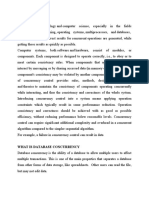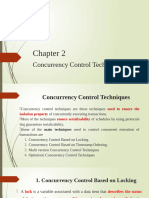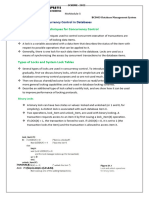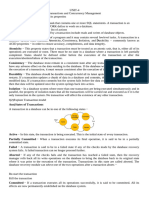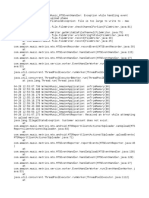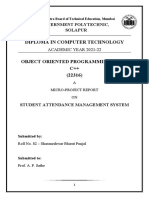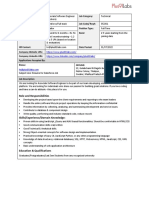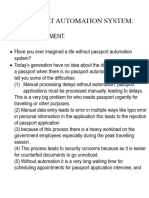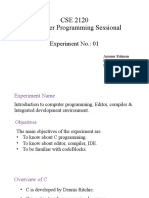0 ratings0% found this document useful (0 votes)
26 viewsConcurrency Control
Concurrency Control
Uploaded by
Tirth NisarConcurrency control coordinates concurrent access to a database in a multi-user system. It allows users to access data simultaneously while preserving consistency. The main challenge is preventing one user's updates from interfering with another's retrievals and updates. Concurrency control is more difficult in distributed databases as users can access data across sites and mechanisms cannot instantly detect transactions at other sites. Effective concurrency control in distributed databases must be resilient to failures while allowing parallel transactions for performance and imposing minimal overhead.
Copyright:
© All Rights Reserved
Available Formats
Download as PDF, TXT or read online from Scribd
Concurrency Control
Concurrency Control
Uploaded by
Tirth Nisar0 ratings0% found this document useful (0 votes)
26 views30 pagesConcurrency control coordinates concurrent access to a database in a multi-user system. It allows users to access data simultaneously while preserving consistency. The main challenge is preventing one user's updates from interfering with another's retrievals and updates. Concurrency control is more difficult in distributed databases as users can access data across sites and mechanisms cannot instantly detect transactions at other sites. Effective concurrency control in distributed databases must be resilient to failures while allowing parallel transactions for performance and imposing minimal overhead.
Original Title
5. Concurrency Control
Copyright
© © All Rights Reserved
Available Formats
PDF, TXT or read online from Scribd
Share this document
Did you find this document useful?
Is this content inappropriate?
Concurrency control coordinates concurrent access to a database in a multi-user system. It allows users to access data simultaneously while preserving consistency. The main challenge is preventing one user's updates from interfering with another's retrievals and updates. Concurrency control is more difficult in distributed databases as users can access data across sites and mechanisms cannot instantly detect transactions at other sites. Effective concurrency control in distributed databases must be resilient to failures while allowing parallel transactions for performance and imposing minimal overhead.
Copyright:
© All Rights Reserved
Available Formats
Download as PDF, TXT or read online from Scribd
Download as pdf or txt
0 ratings0% found this document useful (0 votes)
26 views30 pagesConcurrency Control
Concurrency Control
Uploaded by
Tirth NisarConcurrency control coordinates concurrent access to a database in a multi-user system. It allows users to access data simultaneously while preserving consistency. The main challenge is preventing one user's updates from interfering with another's retrievals and updates. Concurrency control is more difficult in distributed databases as users can access data across sites and mechanisms cannot instantly detect transactions at other sites. Effective concurrency control in distributed databases must be resilient to failures while allowing parallel transactions for performance and imposing minimal overhead.
Copyright:
© All Rights Reserved
Available Formats
Download as PDF, TXT or read online from Scribd
Download as pdf or txt
You are on page 1of 30
Concurrency control is the activity of coordinating concurrent accesses to a
database in a multi-user system.
Concurrency control allows users to access a database in a multi-programmed
fashion while preserving the consistency of the data.
The main technical difficulty in achieving this goal is the necessity to prevent
database updates performed by one user from interfering with database retrievals
and updates performed by other users.
The concurrency control problem is exacerbated in a distributed DBMS (DDBMS),
because in a distributed system users may access data stored at many different
sites, and a concurrency control mechanism at one site cannot be aware of
transactions at other sites instantaneously.
The replication of data items in a distributed database adds extra complexity to the
concurrency control mechanism.
The primary goal of the concurrency control mechanism in a DDBMS is to ensure
that the consistency of the data items is preserved and each atomic action will be
completed in a finite time if the system has not failed.
A good concurrency control mechanism for a DDBMS has the following objectives:
It must be resilient to site and communication failures.
It should permit parallel execution of transactions to achieve maximum concurrency, thus
satisfying performance requirements.
Its computational methods and storage mechanisms should be modest to minimize
overhead.
It should perform satisfactorily in a network environment taking into consideration that it
involves significant communication delay.
It must impose few constraints on the structure of atomic actions of transactions
Concurrency control is the activity of coordinating concurrent accesses to a
database in a multi-user system.
The different anomalies that can arise owing to con-current accesses of data in a
multi-user centralized database environment as well as in a distribute ddatabase
environment are:
lost update anomaly,
uncommitted dependency or dirty read anomaly,
inconsistent analysis anomaly,
non-repeatable or fuzzy read anomaly
phantom read anomaly
Lost update anomaly
This anomaly can occur when an apparently successful completed update
operation made by one user (transaction) is overridden by another user
(transaction).
Uncommitted dependency or dirty read anomaly
This problem occurs when one transaction allows other transactions to read its
data before it has committed and then decides to abort.
Inconsistent analysis anomaly
The problem of inconsistent analysis occurs when a transaction reads several
values from the database but a second transaction updates some of them during
the execution of the first.
Non-repeatable or fuzzy read anomaly
This occurs when one transaction reads the value of a data item that is
subsequently modified or deleted by another transaction.
If the first transaction attempts to re-read the data item either that data item may not
be found or it may read a different value.
Phantom read anomaly
This anomaly occurs when a transaction performing some operation on the
database based on a selection predicate, another transaction inserts new tuples
satisfying that predicate into the same database. This is known as phantom read.
Non-repeatable or fuzzy read anomaly
This occurs when one transaction reads the value of a data item that is
subsequently modified or deleted by another transaction.
If the first transaction attempts to re-read the data item either that data item may not
be found or it may read a different value.
Phantom read anomaly
This anomaly occurs when a transaction performing some operation on the
database based on a selection predicate, another transaction inserts new tuples
satisfying that predicate into the same database. This is known as phantom read.
Concurrency control in a distributed system involves the activity of controlling the
relative order of conflicting operations and thereby ensuring database consistency.
The most obvious classification is done based on the synchronization approaches
that are used in concurrency control techniques to ensure distributed
serializability.
Thus, concurrency control techniques are divided into two broad categories based
on the synchronization techniques: pessimistic concurrency control
mechanisms and optimistic concurrency control mechanisms.
Pessimistic algorithms synchronize the concurrent execution of transactions early
in their execution life cycle, whereas optimistic algorithms delay the
synchronization of transactions until transactions are near to their completion.
Optimistic concurrency control algorithms are based on the assumption that a
conflict is rare and it is more efficient to allow transactions to proceed without
delays.
When a transaction wishes to commit, a check is performed to determine whether
a conflict has occurred or not.
Therefore, optimistic concurrency control algorithms have the desirable properties
of being non- blocking and deadlock free.
In the case of pessimistic concurrency control algorithms, the synchronization of
transactions is achieved earlier before the starting of transaction executions.
The main drawback of pessimistic concurrency control algorithms is that they are
neither deadlock-free nor non-blocking algorithms.
The pessimistic concurrency control algorithms are further classified into locking-
based algorithms, timestamp-based algorithms and hybrid algorithms.
.Similarly, the optimistic concurrency control algorithms are also classified into
locking-based algorithms and timestamp-based algorithms.
A lock is a variable associated with a data item that describes the status of the item with
respect to possible operations that can be applied to it.
Generally, there is one lock for each data item in the database.
Locks are used as a means of synchronizing the access by concurrent transactions to
the database items.
We should allow several transactions to access the same item X if they all access X for
reading purposes only.
This is because read operations on the same item by different transactions are not
conflicting.
However, if a transaction is to write an item X, it must have exclusive access to X.
For this purpose, a different type of lock called a multiple-mode lock is used.
In this scheme—called shared/exclusive or read/write locks—there are three locking
operations: read_lock(X), write_lock(X), and unlock(X).
A lock associated with an item X, LOCK(X), now has three possible states: read-locked,
write-locked, or unlocked.
A read-locked item is also called share-locked because other transactions are allowed
to read the item, whereas a write-locked item is called exclusive-locked because a
single transaction exclusively holds the lock on the item.
When we use the shared/exclusive locking scheme, the system must enforce the
following rules:
1. A transaction T must issue the operation read_lock(X) or write_lock(X) before any
read_item(X) operation is performed in T.
2. A transaction T must issue the operation write_lock(X) before any write_item(X)
operation is performed in T.
3. A transaction T must issue the operation unlock(X) after all read_item(X) and
write_item(X) operations are completed in T.3
4. A transaction T will not issue a read_lock(X) operation if it already holds a read (shared)
lock or a write (exclusive) lock on item X.
b) A nonserializable
a) Two transactions T1 and T2. schedule S that uses locks.
Transactions T1 and T2 do not follow the two-phase locking protocol because the
write_lock(X) operation follows the unlock(Y) operation in T1, and similarly the
write_lock(Y) operation follows the unlock(X) operation in T2.
If we enforce two-phase locking, the transactions can be rewritten as T1’ and T2’, as
shown below.
Now, the schedule shown in Figure b is not permitted for T1’ and T2’ (with their
modified order of locking and unlocking operations) under the rules because T1’
will issue its write_lock(X) before it unlocks item Y; consequently, when T2’ issues
its read_lock(X), it is forced to wait until T1’ releases the lock by issuing an unlock
(X) in the schedule.
It can be proved that, if every transaction in a schedule follows the two-phase
locking protocol, the schedule is guaranteed to be serializable, obviating the need
to test for serializability of schedules.
The locking protocol, by enforcing two-phase locking rules, also enforces
serializability.
Two-phase locking may limit the amount of concurrency that can occur in a
schedule because a transaction T may not be able to release an item X after it is
through using it if T must lock an additional item Y later; or conversely, T must lock
the additional item Y before it needs it so that it can release X.
Hence, X must remain locked by T until all items that the transaction needs to read
or write have been locked; only then can X be released by T.
Meanwhile, another transaction seeking to access X may be forced to wait, even
though T is done with X; conversely, if Y is locked earlier than it is needed, another
transaction seeking to access Y is forced to wait even though T is not using Y yet.
There are a number of variations of two-phase locking (2PL).
A variation known as conservative 2PL (or static 2PL) requires a transaction to lock
all the items it accesses before the transaction begins execution, by pre-declaring
its read-set and write-set.
The read-set of a transaction is the set of all items that the transaction reads, and the
write-set is the set of all items that it writes.
If any of the pre-declared items needed cannot be locked, the transaction does not
lock any item; instead, it waits until all the items are available for locking.
Conservative 2PL is a deadlock-free protocol.
However, it is difficult to use in practice because of the need to pre-declare the
read-set and write-set, which is not possible in many situations.
The most popular variation of 2PL is strict 2PL, which guarantees strict schedules.
In this variation, a transaction T does not release any of its exclusive (write) locks
until after it commits or aborts.
Hence, no other transaction can read or write an item that is written by T unless T
has committed, leading to a strict schedule for recoverability.
Strict 2PL is not deadlock-free.
A more restrictive variation of strict 2PL is rigorous 2PL, which also guarantees
strict schedules.
In this variation, a transaction T does not release any of its locks (exclusive or
shared) until after it commits or aborts, and so it is easier to implement than strict
2PL.
The conservative 2PL must lock all its items before it starts, so once the transaction
starts it is in its shrinking phase;
The Rigorous 2PL does not unlock any of its items until after it terminates (by
committing or aborting), so the transaction is in its expanding phase until it ends.
To ensure serializability of concurrent transactions locking methods are the most
widely used approach.
In this approach, before accessing any data item, a transaction must acquire a lock
on that data item.
When a transaction acquires a lock on a particular data item, the lock prevents
another transaction from modifying that data item.
Based on the facts that read-read operation by two different transactions is non-
conflicting and the main objective of the locking-based concurrency control
techniques is to synchronize the conflicting operations of conflicting transactions,
there are two types of locking modes: read lock (also called shared lock) and write
lock (also called exclusive lock).
If a transaction obtains a read lock on a data item, it can read, but cannot update
that data item.
On the other hand, if a transaction obtains a write lock on a data item, it can read as
well as update that data item.
In the centralized 2PL method, the lock manager or scheduler is a central
component, and hence a single site is responsible for managing all activities of the
lock manager for the entire distributed system.
Before accessing any data item at any site, appropriate locks must be obtained
from the central lock manager.
If a global transaction Ti is initiated at site Si of the distributed system, then the
centralized 2PL for that global transaction should be implemented in the following
way.
The transaction manager at the site Si (called transaction coordinator) partitions
the global transaction into several sub-transactions using the information stored in
the global system catalog.
Thus, the transaction coordinator is responsible for maintaining consistency of
data.
If the data items are replicated, then it is also the responsibility of the transaction
coordinator to ensure that all replicas of the data item are updated.
Therefore, for a write operation, the transaction coordinator requests exclusive
locks on all replicas of the data item that are stored at different sites.
However, for a read operation, the transaction coordinator can select any one of the
replicas of the data item that are available, preferably at its own site.
The local transaction managers of the participating sites request and release locks
from/to the centralized lock manager following the normal rules of the 2PL
protocol.
Participating sites are those sites that are involved in the execution of the global
transaction (sub-transactions).
After receiving the lock request, the centralized lock manager checks whether that
lock request is compatible with the existing locking status or not.
If it is compatible, the lock manager sends a message to the corresponding site that
the lock has been granted; otherwise, the lock request is put in a queue until it can
be granted.
Communicating Messages in Centralized 2PL Method
The main advantage of the centralized 2PL method in DDBMSs is that it is a
straightforward extension of the 2PL protocol for centralized DBMSs; thus, it is less
complicated and implementation is relatively easy.
The deadlock detection can be handled easily, because the centralized lock
manager maintains all the locking information.
Hence, the communication cost also is relatively low.
In the case of DDBMSs, the disadvantages of implementing the centralized 2PL
method are system bottlenecks and lower reliability.
For example, as all lock requests go to the centralized lock manager, that central
site may become a bottleneck to the system.
Similarly, the failure of the central site causes a major failure of the system; thus, it is
less reliable.
This method also hampers the local autonomy.
Primary copy 2PL method is a straightforward extension of the centralized 2PL
method.
Here the responsibilities of the centralized lock manager are distributed among a
number of sites of the distributed system to overcome the disadvantages of the
centralized 2PL method.
Thus, in the primary copy 2PL method lock managers are implemented at several
sites.
Each lock manager is responsible for managing locks for a given set of data items.
For replicated data items, one copy is chosen as the primary copy, and the other
copies are called slave copies.
The choice of the site as the primary site of a data item is flexible.
However, it is not necessary that the primary site hold the primary copy of data
items to manage the locks.
Whenever a transaction is initiated at a site, the transaction coordinator will
determine where the primary copy is located, and then it will send lock requests to
the appropriate lock manager.
If the transaction requires an update operation of a data item, it is necessary to
exclusively lock the primary copy of that data item.
Once the primary copy of a data item is updated, the change is propagated to the
slave copies immediately to prevent other transactions reading the old value of the
data item.
However, it is not mandatory to carry out the updates on all copies of the data item
as an atomic operation.
The primary copy 2PL method ensures that the primary copy is always updated.
The main advantage of primary copy 2PL method is that it overcomes the
bottlenecks of centralized 2PL approach and also reliability increases.
This approach incurs lower communication costs because less amount of remote
locking is required.
The major disadvantage of this method is that it is only suitable for those systems
where the data items are selectively replicated, updates are infrequent and sites do
not always require the latest version of the data.
In this approach, deadlock handling is more complex, as the locking information is
distributed among multiple lock managers.
In the primary copy 2PL method there is still a degree of centralization in the
system, as the primary copy is only handled by one site (primary site).
Distributed 2PL method implements the lock manager at each site of a distributed
system.
Thus, the lock manager at each site is responsible for managing locks on data
items that are stored locally.
If the database is not replicated, then distributed 2PL becomes the same as
primary copy 2PL.
If the database is replicated, then distributed 2PL implements a read-one-write-all
(ROWA) replica control protocol.
In ROWA replica control protocol, any copy of a replicated data item can be used
for a read operation, but for a write operation, all copies of the replicated data item
must be exclusively locked before performing the update operation.
In distributed 2PL, when a global transaction is initiated at a particular site, the
transaction coordinator (the transaction manager of that site is called transaction
coordinator) sends lock requests to lock managers of all participating sites.
In response to the lock requests the lock manager at each participating site can
send a lock granted message to the transaction coordinator.
However, the transaction coordinator does not wait for the lock granted message in
some implementations of the distributed 2PL method.
The operations that are to be performed at a participating site are passed by the
lock manager of that site to the corresponding transaction manager instead of the
transaction coordinator.
At the end of the operation the transaction manager at each participating site can
send the corresponding message to the transaction coordinator.
In an alternative approach, the transaction manager at a participating site can also
pass the “end of operation” message to its own lock manager, who can then release
the locks and inform the transaction coordinator.
Communicating Messages in Distributed 2PL Method
Majority locking protocol was designed to overcome the disadvantage of
distributed 2PL method that all replicas of a data item must be locked before an
update operation.
In this protocol, a lock manager is implemented at each site to manage locks for all
data items stored at that site locally.
The majority locking protocol in a DDBMS works in the following way.
When a transaction requires to read or write a data item that is replicated at m sites,
the transaction coordinator must send a lock request to more than half of them sites
where the data item is stored.
Each lock manager determines whether the lock can be granted immediately or
not.
If the lock request is not compatible with the existing lock status, the response is
delayed until the request is granted.
The transaction coordinator waits for a certain timeout period to receive lock
granted messages from the lock mangers, and if the response is not received
within that time period, it cancels its request and informs all sites about the
cancellation of the lock request.
The transaction cannot proceed until the transaction coordinator obtains locks on a
majority of copies of the data item.
In majority locking protocol, any number of transactions can simultaneously hold a
shared lock on a majority of copies of a data item, but only one transaction can
acquire an exclusive lock on a majority of copies.
However, the execution of a transaction can proceed in the same manner as in
distributed 2PL method after obtaining locks on a majority of copies of the data
items that are required by the transaction.
This protocol is an extension of the distributed 2PL method, and hence it avoids the
bottlenecks of centralized 2PL method.
The main disadvantage of this protocol is that it is more complicated and hence the
deadlock handling also is more complex.
You might also like
- API (Application Program Interface) For File Transfer Between Cbs and SfmsDocument23 pagesAPI (Application Program Interface) For File Transfer Between Cbs and SfmsRahul Joshi100% (1)
- TVL - Computer Systems Servicing: Quarter 1 - Module 3: Computer Hardware Disassembly and AssemblyDocument38 pagesTVL - Computer Systems Servicing: Quarter 1 - Module 3: Computer Hardware Disassembly and AssemblyMa. Clarissa De RamosNo ratings yet
- Transaction ProcessingDocument22 pagesTransaction Processinganon_600750922No ratings yet
- Concurrency ControlDocument4 pagesConcurrency ControlR S KohliNo ratings yet
- Chapter-03-DBA-Concurency ControlDocument32 pagesChapter-03-DBA-Concurency ControlHamza khanNo ratings yet
- cp4 1Document13 pagescp4 1VanshNo ratings yet
- Adms CH-4Document36 pagesAdms CH-4Endalkachew EmareNo ratings yet
- Unit 5Document8 pagesUnit 5dipakdas84630No ratings yet
- Foriegn PolicyDocument16 pagesForiegn PolicyQasim Ali ZafarNo ratings yet
- FINAL DbmsDocument16 pagesFINAL Dbmsjhaa98676No ratings yet
- Unit 4Document14 pagesUnit 4Latika ParasharNo ratings yet
- What Is Concurrency ControlDocument4 pagesWhat Is Concurrency ControlMuhammad InamullahNo ratings yet
- Unit 5TH Notes (DBMS)Document10 pagesUnit 5TH Notes (DBMS)akty785No ratings yet
- Concurrency ControlDocument4 pagesConcurrency ControlSunny KumarNo ratings yet
- Oodbms and OrdbmsDocument61 pagesOodbms and OrdbmsRupsa SenNo ratings yet
- Concurrency ControlDocument10 pagesConcurrency ControlSamuel UdoemaNo ratings yet
- Lecture05 UCCD2303 Transaction Management Part 1Document56 pagesLecture05 UCCD2303 Transaction Management Part 1Teh Kai ZeNo ratings yet
- Binary LocksDocument4 pagesBinary LocksShelvin EchoNo ratings yet
- Mod 5Document14 pagesMod 5Syed HussainNo ratings yet
- Cuttingtools MachineryDocument2 pagesCuttingtools Machinery080Zaid MallickNo ratings yet
- Chapter 9 Transaction Processing Concepts and Concurrency Control TechniquesDocument13 pagesChapter 9 Transaction Processing Concepts and Concurrency Control TechniquesAbhinandan ChivateNo ratings yet
- Unit - 5 DBMS Kca 204Document19 pagesUnit - 5 DBMS Kca 204Mohit SinghNo ratings yet
- Database Questions AnswerDocument7 pagesDatabase Questions AnswerNabina LimbuNo ratings yet
- ACID PropertiesDocument12 pagesACID PropertiesShantel MuchekeNo ratings yet
- 5 Concurrency ControlDocument4 pages5 Concurrency Controlpeter njugunaNo ratings yet
- 1) Concurrency Control: (1) Lost Update Problem: This Problem Occurs When Two Transactions ThatDocument12 pages1) Concurrency Control: (1) Lost Update Problem: This Problem Occurs When Two Transactions Thatbhuvanam417No ratings yet
- Transactions and Concurrency Management: Unit-IvDocument21 pagesTransactions and Concurrency Management: Unit-IvlalithaNo ratings yet
- Concurrency Control Protocols Except Lock Based.Document7 pagesConcurrency Control Protocols Except Lock Based.TerimaaNo ratings yet
- Lecture 4Document5 pagesLecture 4huzaifazafi593No ratings yet
- ADBMS CH 2Document59 pagesADBMS CH 2haileabzinaburedaNo ratings yet
- Adbms Unit 3 NotesDocument28 pagesAdbms Unit 3 Notessurendrareddy mandatiNo ratings yet
- Difference Between Serial Access and Concurrent Access ?Document12 pagesDifference Between Serial Access and Concurrent Access ?ravaliNo ratings yet
- Concurrency Control in DBMSDocument22 pagesConcurrency Control in DBMS21egjcs151No ratings yet
- Desirable Properties of Transactions: Transaction Processing Concepts and Concurrency Control TechniquesDocument24 pagesDesirable Properties of Transactions: Transaction Processing Concepts and Concurrency Control TechniquesAbhiNo ratings yet
- Unit 4 DBMS TranscationDocument34 pagesUnit 4 DBMS TranscationMohit SinghNo ratings yet
- 2PL ProtocolDocument32 pages2PL Protocoljaysurya.jaswanth.karimiNo ratings yet
- Adbms CH 1.bDocument59 pagesAdbms CH 1.bhaileabzinaburedaNo ratings yet
- Chapter 6Document43 pagesChapter 6nat yesuNo ratings yet
- UNIT 4 Chapter 8Document13 pagesUNIT 4 Chapter 8Jyotsna YadavNo ratings yet
- DBMS Unit4 NotesDocument14 pagesDBMS Unit4 NotesManikyarajuNo ratings yet
- Lecturenotes Module-5 BCS403 DatabasemanagementsystemDocument20 pagesLecturenotes Module-5 BCS403 Databasemanagementsystemtharanir.aimlNo ratings yet
- Assignment 05. Group No 39Document13 pagesAssignment 05. Group No 39gasparshemagembNo ratings yet
- Concurrency Control DBMSDocument12 pagesConcurrency Control DBMSpthepronabNo ratings yet
- CO4 Notes Concurrency ControlDocument13 pagesCO4 Notes Concurrency ControlKîrãñ KûmãrNo ratings yet
- TransactionsDocument81 pagesTransactionsANDFAN DAKANo ratings yet
- DBMS Unit4Document37 pagesDBMS Unit4HARSHAN KUMARNo ratings yet
- Unit4 NotesDocument6 pagesUnit4 Notesvanshita9445No ratings yet
- DBMS Classtest2Document10 pagesDBMS Classtest2Mr. Skull EditorNo ratings yet
- Set-B: - A Single Unit of WorkDocument12 pagesSet-B: - A Single Unit of WorkRami ReddyNo ratings yet
- Adbms Unit 3 NotesDocument28 pagesAdbms Unit 3 NotesKvnsumeshChandraNo ratings yet
- Thus Locks Are Used For Two Main Purposes in Oracle Parallel Server: To Provide Transaction Isolation To Provide Cache CoherencyDocument2 pagesThus Locks Are Used For Two Main Purposes in Oracle Parallel Server: To Provide Transaction Isolation To Provide Cache CoherencyvishallchhayaNo ratings yet
- A Short Note On Transaction in Database Management SystemDocument4 pagesA Short Note On Transaction in Database Management SystemImran KabirNo ratings yet
- TransactionsDocument33 pagesTransactionsAhmad MujtabaNo ratings yet
- Dbms - Concurrency ControlDocument20 pagesDbms - Concurrency ControlMegersaNo ratings yet
- Akash Deep Sivastava-17Document13 pagesAkash Deep Sivastava-17061PANKAJ SINGHNo ratings yet
- Unit VI Transaction Processing, Concurrency Control and Recovery TechniquesDocument53 pagesUnit VI Transaction Processing, Concurrency Control and Recovery TechniquesNivedita TuladharNo ratings yet
- Transaction Management Unit IIIDocument28 pagesTransaction Management Unit IIIRahilNo ratings yet
- Concurrency Control TechniquesDocument12 pagesConcurrency Control TechniquesUnknown XYZNo ratings yet
- Transaction Management and Concurrency Discussion Questions SolutionDocument6 pagesTransaction Management and Concurrency Discussion Questions SolutionMohd ArifNo ratings yet
- Function Distributed Database Management SystemsDocument7 pagesFunction Distributed Database Management SystemsAqab ButtNo ratings yet
- Locking System in DBMS: IntrodunctionDocument8 pagesLocking System in DBMS: IntrodunctionAnonymous ZuBQleQNo ratings yet
- FakeNews PaperDocument3 pagesFakeNews PaperTirth NisarNo ratings yet
- 7 Graph DatabaseDocument10 pages7 Graph DatabaseTirth NisarNo ratings yet
- Distributed Databases IntroductionDocument16 pagesDistributed Databases IntroductionTirth Nisar100% (1)
- Deadlock ManagementDocument20 pagesDeadlock ManagementTirth NisarNo ratings yet
- Transaction ManagementDocument21 pagesTransaction ManagementTirth NisarNo ratings yet
- LogDocument7 pagesLogმარიამიNo ratings yet
- Forcepoint ONE Lab Guide v1.0cDocument228 pagesForcepoint ONE Lab Guide v1.0cbilalNo ratings yet
- A Study On Performance Metrics For ANomaly Detection Based On Industrial Control System Operation DataDocument21 pagesA Study On Performance Metrics For ANomaly Detection Based On Industrial Control System Operation DataAnthony AquinoNo ratings yet
- IBM 4690 Programming GuideDocument476 pagesIBM 4690 Programming GuideCesar OrtegaNo ratings yet
- UntitledDocument9 pagesUntitledNana Saoudou LoicNo ratings yet
- Travel Planner Using Generative AiDocument16 pagesTravel Planner Using Generative Aitharunreddy999000No ratings yet
- Subject: PRF192-PFC Workshop 02 SE161455 Trần Quang Vinh Exercise 1 Decimal 4-bit Binary Decimal 8-bit Binary Decimal 16-bit BinaryDocument3 pagesSubject: PRF192-PFC Workshop 02 SE161455 Trần Quang Vinh Exercise 1 Decimal 4-bit Binary Decimal 8-bit Binary Decimal 16-bit BinaryTran Quang Vinh (K16HCM)No ratings yet
- VM-3360VA CE HQ enDocument4 pagesVM-3360VA CE HQ enELHUSSEIN TAHANo ratings yet
- Repair and Maintenance of Mobile Cell PhonesDocument6 pagesRepair and Maintenance of Mobile Cell PhonesPaul NavedaNo ratings yet
- Python Part 1Document351 pagesPython Part 1meetthakkardrive1No ratings yet
- Software EngineeringDocument123 pagesSoftware EngineeringrajanikanthNo ratings yet
- K-Cardinality Minimum Spanning Trees: Finding Degree Constrained For Wireless Sensor NetworksDocument12 pagesK-Cardinality Minimum Spanning Trees: Finding Degree Constrained For Wireless Sensor NetworksJack HamiltonNo ratings yet
- W2020-3150710-APY MaterialDocument1 pageW2020-3150710-APY MaterialMeet PatelNo ratings yet
- Diploma in Computer Technology: Government Polytechnic, SolapurDocument19 pagesDiploma in Computer Technology: Government Polytechnic, SolapurSharaneshwar PunjalNo ratings yet
- Think: 4 Times National Level Award Winner CompanyDocument15 pagesThink: 4 Times National Level Award Winner CompanySabbiruddin KhanNo ratings yet
- Oracle19c Start and Stop ServiceDocument6 pagesOracle19c Start and Stop ServiceFabio Bersan RochaNo ratings yet
- 4-Simplex +big M + Sensityve Analysis (TM 4)Document52 pages4-Simplex +big M + Sensityve Analysis (TM 4)Faydil Iman100% (1)
- Plus91Labs Fresher JDDocument1 pagePlus91Labs Fresher JDVICKY LAKHERANo ratings yet
- Oop PHP MysqliDocument5 pagesOop PHP MysqliRIvå MâŭLänaNo ratings yet
- Passport Automation System-Varsh.88Document8 pagesPassport Automation System-Varsh.88Bandaru PriyankaNo ratings yet
- Introduction To Asynchronous Programming: 1 The ModelsDocument6 pagesIntroduction To Asynchronous Programming: 1 The ModelsAsheesh MathurNo ratings yet
- Linux User Guide Aardvark Embedded SolutionsDocument10 pagesLinux User Guide Aardvark Embedded SolutionsOscar Javier GomezNo ratings yet
- OpenScape 4000 Assistant V8 Signalling and Payload Encryption Administrator Documentation Issue 2Document18 pagesOpenScape 4000 Assistant V8 Signalling and Payload Encryption Administrator Documentation Issue 2slimaneNo ratings yet
- CSE 2110 Experiment 01Document18 pagesCSE 2110 Experiment 01আমানুর আকাশNo ratings yet
- Ov2500 Nms e 46r1 Install RevaDocument268 pagesOv2500 Nms e 46r1 Install RevaOscar Bracamonte Z.No ratings yet
- 01-18 VXLAN CommandsDocument154 pages01-18 VXLAN CommandsShubhang BhoiwarNo ratings yet
- 5.1 - Microcontroller and Microprocessor ArchitectureDocument35 pages5.1 - Microcontroller and Microprocessor ArchitectureWinter NaiNo ratings yet
- CH03 COA11e UpdatedDocument60 pagesCH03 COA11e UpdatedUvanesNo ratings yet















